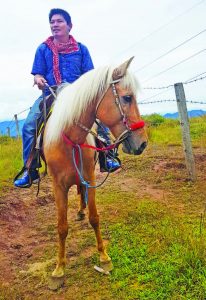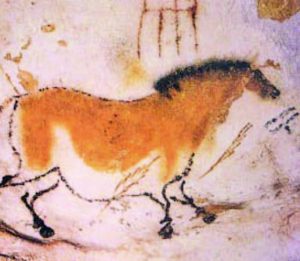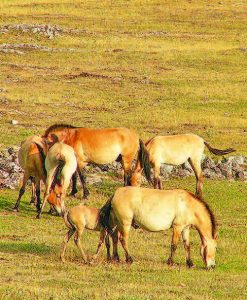
Unless you’ve been to the steppes of Mongolia or a very select number of zoos, every horse you’ve ever seen is domesticated. There are about 60 million horses on Earth, but only 1,500 of them are truly wild. The so-called wild mustangs of North America, the brumbies of Australia and Camargue horses of France live free, but are descended from domesticated horses who escaped their masters centuries ago.

Gregg Yan not atop a Przewalski’s horse but a Palomino pony in the Cordilleras. He hopes to visit Mongolia to see the world’s last wild horses someday. | 📸 Bam Dionisio
Up until the early 1900s, two types of truly wild horses existed—the European tarpan (Equus ferus ferus) and the Przewalski’s horse (Equus ferus przewalskii), which for millions of years has thrived in the steppes of Mongolia.
The world’s last tarpan died in 1909 and the subspecies was declared extinct, but Pzewalski’s horses have survived to the modern age.
The First Horses
The horses you see today look very different from their ancestors from 50 million years ago. Originating in the forests of North America, Eohippus was brown and dog-sized, scuttling through the thick vegetation of forests like a small deer. With the advent of natural climate change came drier weather, more conducive for the growth of grasslands. Eohippus evolved to become several taller, longer-legged species like Merychippus, much better-suited to grazing in open fields and escaping from predators not by hiding but by running.

Przewalski’s horse painting inside the Lascaux cave complex in Southern France, estimated to be 17,000 years old. | 📸 Wikipedia/Prof Saxx
Today, all equine species save for horses, donkeys, asses, and zebras are gone, and the modern horse (Equus caballus), which was domesticated around 3,500 BCE, has become among the most familiar and well-loved animals on Earth.
I visited the Smithsonian National Zoo in North America last year and saw, to my great delight, real Przewalski’s horses! I’ve since visited the horses a few times, spurring an idea: to see the world’s last wild horses in Mongolia.
Przewalski’s Discovery
Pronounced ‘shuh-val-ske’, the Przewalski’s or P-horse is still found in the harsh steppes (grasslands nearly devoid of trees and usually freakishly cold) of Mongolia, plus on nature reserves in Ukraine, Russia, Kazakhstan, Hungary, and China. The wild horse is yellowish in color: small, stocky and heavily-built with a large head, thick neck and short legs. A zebra-like mohawk of a mane adorns the head and a dark ‘eel-stripe’ continues from the mane along the backbone to the base of a black tail. In the winter the horses grow thick, shaggy coats, making them look more like donkeys than horses.

A herd of wild Takhi or Przewalski’s horses. | 📸 Wikipedia/Jairo Feris Delgado
First described in 1881 by Russian explorer Nikolai Przhevalsky when he encountered them (along with new species of gazelle and camel) in Mongolia, hunting for zoos and meat almost pushed the species to extinction. By the end of the 1950s, only 12 remained. Half a century of successful conservation in zoos allowed the reintroduction of the wild horses back to Mongolia, China, and Kazakhstan. Over 1,500 are thought to survive to this day.
Animal Scene readers who want to see the world’s last wild horses will have to fly to Mongolia’s capital, Ulaanbaatar, eight hours by plane from Metro Manila. From the city, just drive west out of the main highway until you reach the Khustai Mountains Road, where you’ll turn left to enter Hustai National Park. The drive takes about two hours and visitors are advised to contact park management online before going. In addition to the horses (locally called Takhi), gazelle and wild deer can be seen grazing around the park’s hills.
My dream next year is to visit the Hustai National Park, preferably atop one of the strong Mongol horses which Genghis Khan’s riders rode to conquer the world. Now that would be a trip for any horse buff: galloping atop one of the planet’s best warhorses to pay homage to its last wild ones!
This appeared in Animal Scene magazine’s June 2018 issue.